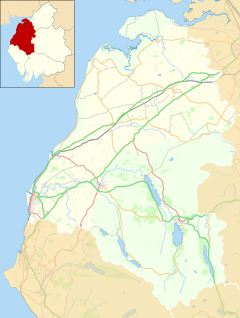Linefoot | |||||
|---|---|---|---|---|---|
| General information | |||||
| Location | Linefoot, near Cockermouth, Allerdale England | ||||
| Coordinates | 54°41′36″N 3°25′47″W / 54.6933°N 3.4298°W | ||||
| Grid reference | NY079340 | ||||
| Platforms | 2 (island platform) | ||||
| Other information | |||||
| Status | Disused | ||||
| History | |||||
| Original company | Maryport and Carlisle Railway | ||||
| Key dates | |||||
| 4 January 1888 | Opened | ||||
| July 1897 | Closed | ||||
| 1 September 1908 | Opened | ||||
| 1 November 1908 | Closed to passengers[1] | ||||
| 1 September 1921 | Closed completely[2] | ||||
| |||||

Cleator & Workington Junction Rly | |||||||||||||||||||||||||||||||||||||||||||||||||||||||||||||||||||||||||||||||||||||||||||||||||||||||||||||||||||||||||||||||||||||||||||||||||||||||||||||||||||||||||||||||||||||||||||||||||||||||||||||||||||||||||||||||||||||||||||||||||||||||||||||||||||||||||||||||||||||||||||||||||||||||||||||||||||||||||||||
|---|---|---|---|---|---|---|---|---|---|---|---|---|---|---|---|---|---|---|---|---|---|---|---|---|---|---|---|---|---|---|---|---|---|---|---|---|---|---|---|---|---|---|---|---|---|---|---|---|---|---|---|---|---|---|---|---|---|---|---|---|---|---|---|---|---|---|---|---|---|---|---|---|---|---|---|---|---|---|---|---|---|---|---|---|---|---|---|---|---|---|---|---|---|---|---|---|---|---|---|---|---|---|---|---|---|---|---|---|---|---|---|---|---|---|---|---|---|---|---|---|---|---|---|---|---|---|---|---|---|---|---|---|---|---|---|---|---|---|---|---|---|---|---|---|---|---|---|---|---|---|---|---|---|---|---|---|---|---|---|---|---|---|---|---|---|---|---|---|---|---|---|---|---|---|---|---|---|---|---|---|---|---|---|---|---|---|---|---|---|---|---|---|---|---|---|---|---|---|---|---|---|---|---|---|---|---|---|---|---|---|---|---|---|---|---|---|---|---|---|---|---|---|---|---|---|---|---|---|---|---|---|---|---|---|---|---|---|---|---|---|---|---|---|---|---|---|---|---|---|---|---|---|---|---|---|---|---|---|---|---|---|---|---|---|---|---|---|---|---|---|---|---|---|---|---|---|---|---|---|---|---|---|---|---|---|---|---|---|---|---|---|---|---|---|---|---|---|---|---|---|---|---|---|---|---|---|---|---|---|---|---|---|---|---|---|---|---|
| |||||||||||||||||||||||||||||||||||||||||||||||||||||||||||||||||||||||||||||||||||||||||||||||||||||||||||||||||||||||||||||||||||||||||||||||||||||||||||||||||||||||||||||||||||||||||||||||||||||||||||||||||||||||||||||||||||||||||||||||||||||||||||||||||||||||||||||||||||||||||||||||||||||||||||||||||||||||||||||
Maryport and Carlisle Railway | |||||||||||||||||||||||||||||||||||||||||||||||||||||||||||||||||||||||||||||||||||||||||||||||||||||||||||||||||||||||||||||||||||||||||||||||||||||||||||||||||||||||||||||||||||||||||||||||||||||||||||||||||||||||||||||||||||||||||||||||||||||||
|---|---|---|---|---|---|---|---|---|---|---|---|---|---|---|---|---|---|---|---|---|---|---|---|---|---|---|---|---|---|---|---|---|---|---|---|---|---|---|---|---|---|---|---|---|---|---|---|---|---|---|---|---|---|---|---|---|---|---|---|---|---|---|---|---|---|---|---|---|---|---|---|---|---|---|---|---|---|---|---|---|---|---|---|---|---|---|---|---|---|---|---|---|---|---|---|---|---|---|---|---|---|---|---|---|---|---|---|---|---|---|---|---|---|---|---|---|---|---|---|---|---|---|---|---|---|---|---|---|---|---|---|---|---|---|---|---|---|---|---|---|---|---|---|---|---|---|---|---|---|---|---|---|---|---|---|---|---|---|---|---|---|---|---|---|---|---|---|---|---|---|---|---|---|---|---|---|---|---|---|---|---|---|---|---|---|---|---|---|---|---|---|---|---|---|---|---|---|---|---|---|---|---|---|---|---|---|---|---|---|---|---|---|---|---|---|---|---|---|---|---|---|---|---|---|---|---|---|---|---|---|---|---|---|---|---|---|---|---|---|---|---|---|---|---|---|---|---|
| |||||||||||||||||||||||||||||||||||||||||||||||||||||||||||||||||||||||||||||||||||||||||||||||||||||||||||||||||||||||||||||||||||||||||||||||||||||||||||||||||||||||||||||||||||||||||||||||||||||||||||||||||||||||||||||||||||||||||||||||||||||||
Linefoot railway station, sometimes referred to as Linefoot Junction and sometimes as Linefoot Goods, briefly served the scattered community around the crossroads at Linefoot, near Cockermouth in Cumberland (now in Cumbria), England.[3][4][5]
The station was a later addition to the Maryport and Carlisle Railway's (MCR) 5 miles 77 chains (9.6 km) single track Derwent Branch which opened in 1867 to connect their main line near Bullgill with the Cockermouth, Keswick and Penrith Railway near Brigham. In March 1887 the Cleator and Workington Junction Railway (C&WJR) opened its "Northern Extension" from Workington Central through Seaton (Cumbria) and Great Broughton, meeting the Derwent Branch at a new junction at Linefoot. Linefoot opened as a goods only station in 1887, its first stationmaster being Daniel Dickinson.[6]
The C&WJR built this 7 miles 30 chains (11.9 km) line to connect the C&WJR with Carlisle and the Solway viaduct. The line was double track from Workington to Seaton, then single through Great Broughton to Linefoot. Exchange sidings were laid at Linefoot and in 1898 a connection was laid between the Northern extension and Alice Pit a short distance south of Linefoot station.
Most stations on C&WJR lines had heavy industrial neighbours, such as ironworks next to Cleator Moor West, or served primarily industrial workforces, such as Keekle Colliers' Platform. Linefoot, however, was and remains open farming country with no village as such.
- ^ Butt 1995, p. 108.
- ^ McGowan Gradon 2004, p. 68.
- ^ McGowan Gradon 2004, pp. 6 & 63.
- ^ Smith & Turner 2012, Map 26.
- ^ Jowett 1989, Map 36.
- ^ McGowan Gradon 2004, p. 70.

